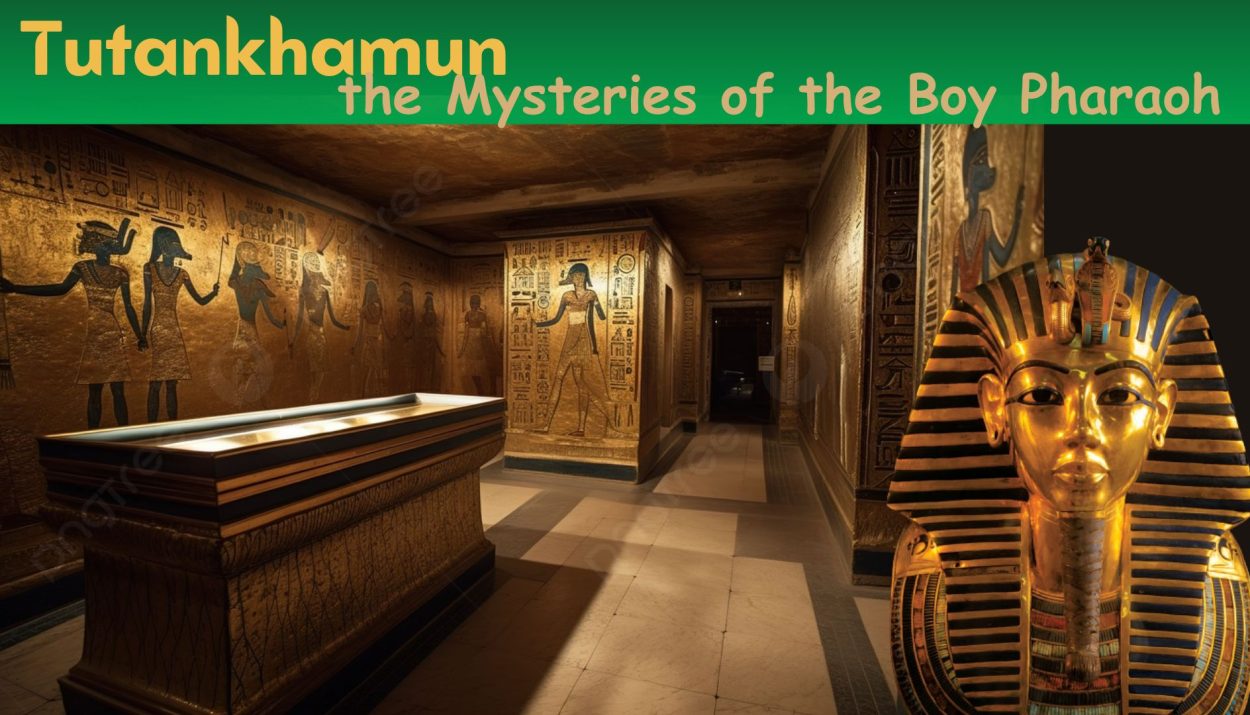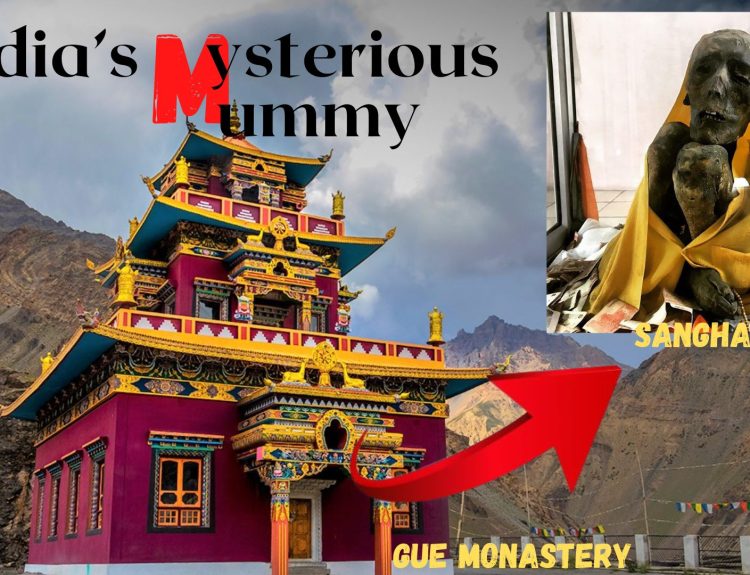Ancient Egypt, a civilization steeped in history and culture, has left an indelible mark on our understanding of the past. Among its many pharaohs, one figure stands out, not for grand conquests or sprawling pyramids, but for the enigma that shrouds his life and the treasures within his tomb. Welcome to the world of Tutankhamun: Unravelling the Mysteries of the Boy Pharaoh, a young pharaoh whose story continues to captivate anthropologists and historians alike.
The Life of Tutankhamun
Early Years
Tutankhamun, also known as King Tut, ascended to the throne at a remarkably young age, around 9 or 10 years old. Genetic analysis has confirmed that King Tut was indeed the grandchild of the renowned pharaoh Amenhotep III and highly likely the offspring of Akhenaten. Akhenaten was a figure of controversy during the 18th dynasty of Egypt’s New Kingdom (c. 1550-1295 B.C.), as he brought about significant changes to the established religious order by promoting the exclusive worship of the sun god Aten and relocating Egypt’s religious centre from Thebes to Amarna.

Reign and Restoration
Spanning from 1332 to 1323 BCE, Tutankhamun’s reign was relatively brief but impactful. Despite his tender age, he presented himself as a warrior king, often depicted in the grandeur of battle on a chariot. Crucially, he played a pivotal role in reinstating the traditional religious practices of Egypt, which had been disrupted during his father’s rule in favour of Aton worship. Tutankhamun’s reign heralded a return to the veneration of the god Amon and a resurgence of Egypt’s time-honoured ways.
The Mystery of His Death
The mystery surrounding Tutankhamun’s life centres on the circumstances of his untimely death. Despite his towering stature, he was physically fragile, primarily due to a debilitating bone ailment that affected his left foot. Additionally, the practice of intermarriage within the Egyptian royal lineage likely played a role in the compromised health and early demise of the young king. In 2010, DNA tests revealed that Tutankhamun’s parents were indeed siblings, and remarkably, his wife, Ankhesenamun, shared a half-sibling relationship with him.
The presence of a hole at the back of Tutankhamun’s skull has led some historians to speculate about the possibility of assassination. However, recent investigations suggest that this opening resulted from the mummification process rather than foul play. Furthermore, CT scans conducted in 1995 uncovered an infected broken left leg, providing insight into the extent of his physical ailments. Adding to this complex health picture, DNA analysis of King Tut’s mummy presented compelling evidence of multiple malaria infections, all of which may have collectively contributed to his tragically premature demise.
Various theories have been proposed, ranging from accidents and illnesses to the potential of foul play. However, the precise cause of his death remains an enigmatic puzzle yet to be solved.
Read- Traces of Alexander the Great’s Final Resting Place
The Discovery of Tutankhamun’s Tomb
The year 1922 marked a turning point in our understanding of Tutankhamun when British archaeologist Howard Carter stumbled upon his tomb in the Valley of the Kings. This discovery ranks among the most significant archaeological breakthroughs of the 20th century, thanks to the pristine condition of the tomb and the astounding array of treasures it concealed.

Carter and his team embarked on a painstaking excavation, leading to the revelation of a concealed chamber deep beneath the sands. Inside, they beheld an awe-inspiring archaeological wonder: a treasure trove adorned with gold and ebony artefacts, meticulously arranged before yet another chamber. This inner sanctum was not only guarded by imposing statues but also sealed with remarkable intricacy, using a combination of rope knots and clay. It was within this sacred space that the long-forgotten resting place of King Tutankhamun was unveiled.
Tutankhamun’s tomb yielded a staggering collection of artefacts, each with its own unique purpose, shedding light on the beliefs and customs of the time. The mummy itself was a marvel to behold, adorned with a lavish array of jewels and crowned by an exquisite mask crafted from solid gold, glass, and precious stones. Among the over 5,000 priceless items were golden statues of exquisite craftsmanship.
At the heart of the burial chamber lay the Pharaoh’s mummy, adorned with a resplendent golden death mask, nestled within a coffin crafted from over 200 pounds of solid gold. Removing the mask revealed a surprising detail—the detachment of the beard, unveiling the youthful countenance beneath. This detail adds to the intrigue of King Tutankhamun’s tomb; unlike the final resting place of an aged ruler, this tomb belonged to a teenage pharaoh, explaining its relatively modest size.

Presently, the most delicate relics, such as the burial mask, stay within the borders of Egypt. Tutankhamun’s mummy is still showcased inside the tomb situated in the Valley of the Kings, specifically in the KV62 chamber. His elaborate coffins have been substituted with a climate-controlled glass enclosure. Meanwhile, his iconic golden mask is exhibited at the Egyptian Museum in Cairo. However, it’s worth noting that the Tutankhamun collection is slated to relocate to the Grand Egyptian Museum, often referred to as GEM, situated in close proximity to the Pyramids of Giza.

The Curse of the Pharaohs
A shadow of mystique surrounds the expedition led by Howard Carter. During the early months of 1923, the British archaeologist Howard Carter, in collaboration with his financial supporter George Herbert, also known as Lord Carnarvon, conducted a significant event. They officially unveiled the once-concealed burial chamber of the youthful pharaoh, Tutankhamun, in the Valley of the Kings in Egypt. However, just two months after this momentous discovery, tragedy struck when Lord Carnarvon succumbed to blood poisoning, a result of an infected mosquito bite on his cheek.
Tragically, various other members met their untimely demise shortly after the reopening of Tutankhamun’s burial chamber, leading to the emergence of the “Curse of the Pharaohs” legend. While science dismisses this as coincidence, it endures in popular culture, adding to the pharaoh’s enigma.
Conclusion
Tutankhamun’s tale is a testament to the enduring allure of ancient Egypt. His brief life and the treasures within his tomb continue to captivate anthropologists, historians, and enthusiasts alike, providing a window into a bygone era. As we unravel the mysteries of Tutankhamun, we draw nearer to understanding the enigmatic tapestry of our shared human history. King Tut remains an enduring symbol of the grandeur and intrigue of ancient Egypt.
A century after its discovery, Tutankhamun’s treasure continues to captivate the world, solidifying the Valley of the Kings as the ultimate destination for unlocking the secrets of Egypt’s renowned Pharaohs.
“If you have any recommendations, please don’t hesitate to get in touch with us.”
References
THE CURSE OF KING TUT’S TOMB- National Geographic
Is the curse of King Tut real?- History
Digging up trouble: beware the curse of King Tutankhamun- The Guardian
Tutankhamun (1336 BC – 1327 BC)- BBC







